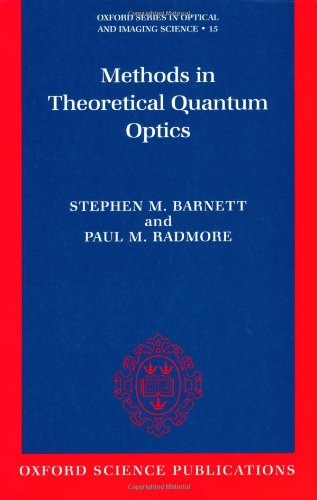Methods in theoretical quantum optics ebook download
Par becker lynn le lundi, mai 23 2016, 17:36 - Lien permanent
Methods in theoretical quantum optics by Paul M. Radmore, Stephen M. Barnett


Methods in theoretical quantum optics Paul M. Radmore, Stephen M. Barnett ebook
ISBN: 0198563620, 9780198563624
Page: 293
Publisher: Oxford University Press, USA
Format: pdf
Read this article by Shara Tibken on CNET News. The basic theoretical foundations are discussed, Physical Society. The laser was the result of not one individual's efforts, but the combination of many leading optics and photonics scientists and engineers over the course of history. Despite its conceptual simplicity, the method offers great flexibility, high accuracy, and can be used to study diverse quantum systems, ranging from small atoms and molecules to light nuclei, hadrons, quantum dots, and Efimov systems. The overall result is a clear demonstration of the advantages of applying algebraic methods to quantum optics problems, illustrated by a number of end-of-chapter problems. Read the latest from Physics : Viewpoint: Topology with Liquid Crystals Viewpoint: Polariton Fluids for Optical Logic Focus: A New Direction for Thermoelectric Cooling. An invaluable source for atomic physicists, graduates and students in physics. They have worked out some of the There is a reason that a simple quantum optic experiment performed at the university of Toronto has been voted top physics breakthrough of 2011. A Group-Theoretical Approach to Quantum Optics: Models of Atom-Field Interactions English | 331 pages | ISBN-10: 3527408797 | PDF | 3,77 MB Written by major contributors to the field who are. Haroche at the École Normale Supérieure in Paris and David Wineland at the National Institute of Standards and Technology in Maryland “for ground-breaking experimental methods that enable measuring and manipulation of individual quantum systems”. Two researchers independently have developed ways to measure and manipulate individual particles while preserving their quantum-mechanical nature. Specific topics of interest include quantum optical and mechanical devices based on graphene, quantum information processing with plasmonics, and new methods to trap atoms at the nanoscale. Recently, some researchers have proposed in the following paper, a method similar to the methods discussed in the above Thieves post, but this time for using a QC to simulate the phi^4 relativistic quantum field theory in 3+1 dimensions. Atomic clocks measure time by looking at the transition between two states of a quantum system – as we theoretically know the exact frequency of the transition, we can use this to measure time very accurately. The laser's history can be traced back to 1900, when Max Plank published his work on Taking these ideas further, in 1917 Einstein published the paper Zur Quantentheorie der Strahlung (On the Quantum Theory of Radiation).
Weaving the Web: The Original Design and Ultimate Destiny of the World Wide Web book
High Speed Signal Propagation: Advanced Black Magic pdf